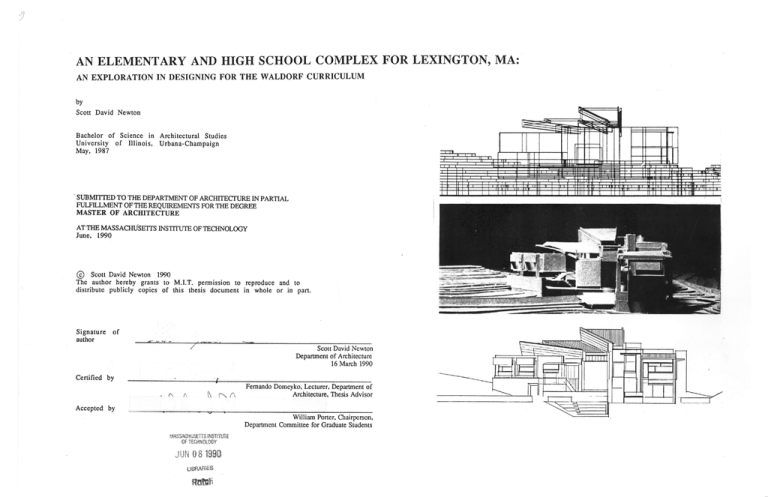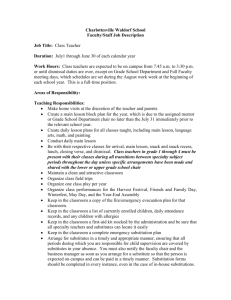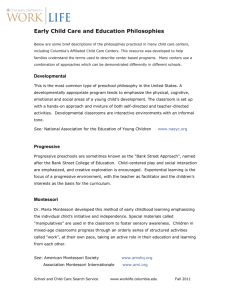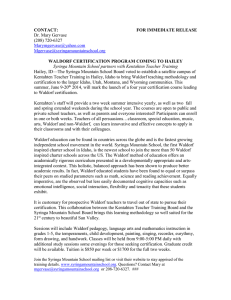I AN ELEMENTARY AND HIGH SCHOOL ...
advertisement

AN ELEMENTARY AND HIGH SCHOOL COMPLEX FOR LEXINGTON, MA: AN EXPLORATION IN DESIGNING FOR THE WALDORF CURRICULUM by Scott David Newton I I Bachelor of Science in Architectural Studies University of Illinois, Urbana-Champaign May, 1987 IT' I SUBMITTED TO THE DEPARTMENT OF ARCHITECTURE IN PARTIAL FULFILLMENT OF THE REQUIREMENTS FOR THE DEGREE MASTER OF ARCHITECTURE AT THE MASSACHUSETS INSTITUTE OF TECHNOLOGY June, 1990 @ Scott David Newton 1990 The author hereby grannts to M.I.T. permission to reproduce and to distribute publicly copi es of this thesis document in whole or in part. Signature author of Scott David Newton Department of Architecture 16 March 1990 Certified by Fernando Domeyko, Lecturer, Department of Architecture, Thesis Advisor r\\ Accepted by William Porter, Chairperson, Department Committee for Graduate Students !dASSACHUSUiTIS INSTTUTE OF TECHNOLOGY JUN 08 1990 USRAReS I I I Ir i Ii 6n Ii I. H i I A 1I 11 f1 H 11 II I i i i h u I m . i I I 11 1 1 1 v! 6 vilillin I1 1I 1 11 I I II I It i A . I ii u 14--y a 1! I I1 TIT Ih If I II I HI Rial 11 1FLI- I 6 1 11 1 1H- ii I9 s, , a 4 i'H i I Irli ;--& I pi6 W ' v ' ' vT iTrW 1v 9TYW i i W ;I, , - - W M, _rT if I I 1o'M w-mi 1 li "awMello, 11. 11 . 11 W , , .' L,4 I6:maim mansionewas mi'man i TI Ii II Tt 4%f TI "f iI !, wi i I , lk i , , R I N M IN , p p 4 H , , W N 4HH -TT TF-NT--Tff-Y-TF-.rWT rT-m -TT----TT-IrT-T- 4614i 0---rTrrr-= , I '1 -T--7 !'ill A1 1, , 'Tlonlossam 1 lil w j 11111 n II1 H N . . TIT it H i ., i i I.w 4-r to the Department of Architecture on March 28, 1989 in partial fulfillment of the requirements of the degree Master of -Submitted Architecture. ABSTRA CT AN ELEMENTARY AND HIGH SCHOOL COMPLEX FOR LEXINGTON, MA: AN EXPLORATION IN DESIGNING FOR THE WALDORF CURRICULUM by Scott David Newton This thesis is an examination of how elementary and high school education within the context of the Waldorf School Curriculum manifests itself in the physical form of its built environment. This project is therefore the documentation of a design process that accommodates the Waldorf School curriculum and a proposal for a school complex intended to embody the many unique characteristics of this educational system. Documentation of the design process includes recording all the various methods of representation employed during the development of the final design. In this thesis emphasis is placed on the role of computer aided design and representation in the transformation of a Documentation of the design process is concept into architecture. intended to show the manner in which the various methods of representation facilitate a better understanding of both the concept and the final solution for this project. Thesis Supervisor: Fernando Domeyko Lecturer Department of Architecture 3 -4 For my family 5 ACKNOWLEDGEMENTS To: Fernando Domeyko Mathew David Ronna Bill Eric Marzio Caroline the Droege Studio and a very special thanks to Vella Chan For their ceaseless patience, attention, encouragement, and laughter. 7 TABLE OF CONTENTS ABSTRACT 3 DEDICATION 5 ACKNOWLEDGEMENTS 7 THE WALDORF CURRICULUM i1 THE SITE 14 THE BUILDING CONCEPT 19 Concept Reference No. 1 21 Concept Reference No. 2 22 Concept Reference No. 3 23 Design Concept 24 TRANSFORMATION OF THE CONCEPT 27 Process Reference No. 1 28 Process Reference No. 2 30 Design Process 33 SHADE AND SHADOW STUDIES 39 THE FINAL DESIGN 43 SUMMARY OF DESIGN PROCESS 53 BIBLIOGRAPHY 55 9 -A THE WALDORF CURRICULUM The following paragraphs give some insight into the Waldorf school curriculum and organization at the elementary level. The purpose of this thesis is not to endorse, evaluate, or critique the curriculum in any way. This is merely a summary of the Waldorf curriculum as it exists; it also includes some of the ideas and values that helped generate it. The most prominent and unique feature of the Waldorf curriculum is the relationship that develops between the Waldorf teacher and the student From first throughout the elementary education. grade to eighth grade a student will be instructed by the same teacher for most of their courses. The location of an instructor's class is changed within the school building from year to year but the students remain with the same teacher for eight years. Unlike most conventional schools a Waldorf teacher is not associated with a particular subject or location within the school. Much of the early education at the Waldorf School is based on the Waldorf educator's belief that children are primarily a "sense organ" before the age of seven. The body, soul, and spirit exist as a unity. After the age of seven the child needs the teacher as "artist" to help the child assimilate and understand knew concepts on an intellectual level rather than the simple memorization of lists and facts. Waldorf educators believe that superficial knowledge are forgotten, at least as far as But the subjects recall is concerned. "blocks" are those in which the goal is facts and instant taught in to instill 11 1 and thought--not to produce In addition the process of factfilled computers. "forgetting" is part of the process of assimilating the material, of sorting out the "facts" from the deeper And since the curriculum is cumulative knowledge. and comprehensive, the children return to each concepts, processes, "block" later on. Subjects such as English, arithmetic, foreign languages require constant exercise, and these are taken up continuously rather than in blocks. Art is the keystone of the Waldorf education, following aphorism suggests: child's most deeply ingrained Within the Waldorf curriculum these artistic activities are not merely "expressive"; they are also Thus, artistic activities are woven into formative. the entirety of the Waldorf curriculum. as the The child who learns to work with the hands becomes a laborer: The child who learns to work with the hands and the brain becomes a craftsman; The child who learns to work with the hands, the brain and the heart becomes an artist. The especially characteristic quality of childhood, and is seen early in the child's instinct to give physical expression to feelings and emotions. When children are allowed to work out these feelings through artistic activities, their deepest needs can be most fully and clearly and satisfyingly expressed. habits and behavior patterns form very early, when he or she At this is at the "copying" stage of development. time, artistic expression is more suitable than any other form of activity for cultivating positive habits and patterns in children, and especially for insuring that they are able later in life to take a perceptive In addition to the curriculum already described, attention to the child's physical body is a Simple fundamental part of the Waldorf curriculum. circle games are played in the early grades, leading to around the third year to team sports, track and Adventure field games, and "Bothmer" gymnastics. stories can be acted out on gymnastic apparatus and on the playing field. By the sixth year, attention to the physical body is taken up with even greater consciousness; for instance, the children will begin to perceive the relationships between their gymnastics exercises and the geometric patterns they are constructing at their desks. It is the Waldorf interest in the world about them. educator's belief that artistic activities permit the child to give outward expression to impulses which come from the inner life. This process puts the child's inner nature in touch with his or her physical being, and thus work in art has an important Even in the earliest years, work on a balance beam and exercises with beanbags and copper rods are and are developing poise and self-assurance, enabling young children to achieve conscious harmony with the space in which they live. influence even on physical growth and development. This intensive bond between body and "soul" is an A prerequisite to "achieving harmony with the space in which one lives" is an understanding of the "nature" and origin of elements that make up a According to the teachers particular environment. at the Waldorf school, children at a young age receive too much of what they learn in an "abstracted" form. Examples of this include; a misunderstanding of distances due the extensive use of the automobile, confusion over the origin of prepackaged food found in stores, and the distorted It is the view of adult life available on television. belief of Waldorf school educators that these "manmade" interventions create a serious problem in of their to a child's perception reference environment and their own orientation within it. It is one of the primary goals of the Waldorf curriculum to give young children an understanding of the process by which their surroundings were made. A clear understanding of how things get from "point A" to "point B" is necessary for a successful association with the natural and man-made world. 13 --- THE SITE ILI Above is existing school building to be demolished View over looking dry lake bed and existing playing fields The site is located in Lexington, Massach usetts approximately twenty miles northwest of the ci ty of Boston and one half mile south of Lexington's H istoric district. The site is angled twenty degrees west of the north axis. It is bounded by Massachusetts Aven ue on the west and south, a low density resid ential neighborhood on the north, and the Boston and Maine Railroad on the east. The site as well as the to wn of Lexington in general can be characterized as a low density, picturesque community with gently, r olling hills and moderately wooded areas. 14 The site includes a dry lake bed approximately s ixteen feet below the level of the school building. The dr y lake bed serves as the site of the playing fields for the school and is located on the northeastern side of the site. There are two small hills; the tallest of which rises twelve feet above the first floor level of the school. The proposed school is located on an axis formed be tween the two hills and along the crest of the shoreline of the dry lake bed. mmlmm View looking south View looking towards Massachusetts Avenue, Lexington 15 -r-. J61.0 ldO64 A IL .js) .167. 16 6. /dd AL d6.3 .100 1 AL 1 6,; 1 AL 165. .4b /61.4 A AL '63.I .,~ 7< AL 104 9 .163:3 IL EXISTING SITE AND SURROUNDING AREA 17 THE BUILDING CONCEPT -- K -N - N N KN IN~ pz - - The concept for the school was developed with the organization three major issues in mind: of the school, curriculum requirements, and movement about the site. Before developing a concept several organizational references of These institutional buildings were analyzed. were narrowed down to three different These three organizations have organizations. one important feature in common; they all develop a relationship between a large collective space and smaller private spaces. In most of the references the private spaces define the large collective space and the large collective space incorporates or includes the primary access. The final concept for the school borrows from these organizational references. The following pages diagram the references used in developing the concept. N1 19 / / A / / / / / / / 'I, / / / / / / \ CONCEPT REFERENCES 11 1. r HOME FOR SINGLE PARENT FAMILIES by Aldo van Eyck The primary located above access the and collective private spaces. space are Each private apartment is accessed by its own stair leading to the first floor. Each apartment contains both its down own smaller collective defined by the curved wall on the first floor. Computer generated diagram 21 CONCEPT REFERENCE: FINLAND SAYNATSALO, TOWN-HALL, by Alvar Alto The collective the private collective floor. space The collective. this been private primary the The particular elevated level of the site. 22 and option large on defined Interaction spaces. space with is space access is approximately is sides the limited surrounds collective four between spaces to bypass reference all the to feet one of the is outdoors differentiated eight large collective on one side which by by in having above the CONCEPT REFERENCE: APOLLO MONTESSORRI by Herman Hertzberger The private spaces are located on both the first and The primary access is defined by a second floors. balconies that service the classrooms and contribute to defining a intermediate zone between the classrooms and the collective spaces. series of stairs and 28 N 23 THE BUILDING CONCEPT The structure and substance of the Wal dorf curriculum has an obvious effect on the forms an d materials used to design and construct a building to Issues relating to fc ~rm, house such a school. surfaces, and movement are important concerns to Waldorf educators with respect to the orienta tion and education of the child in the Wal dorf curriculum. The physical form of the school sh ould conform to the natural contours of the site as miuch Access and movement through the as possible. school should be in a clear direction to help estab lish These specifications are importan in orientation. order to help the child develop a relationship and Such La understanding of their environment. in an would not be possible relationship environment composed of monolithic forms and synthetic materials because they are "abstracti ons" and too severe a deviation from the natural origin of the elements that compose their environment. Other architectural elements to be consid ,red The use of natural 1ight include light and color. where possible is important because artificial ligh t is an abstraction in the same manner as th ose mentioned above. Color is important in the Wal dorf school because of the effect it has on the chi ld's mood. The walls of classrooms and work areas are color coded according to the particular mood or disposition that is appropriate for the activity and stage in their cognitive development. 24 The specifications mentioned previously pertain to the design of the elementary school portion of the complex. According to Waldorf educators the f orm of the high school portion of the complex need not follow all of the specifications listed above because the child has matured enough to understand and relate to abstract forms by the time they reach the Therefore there is considerably high school level. more freedom regarding the design of the high N school within the complex. Each of the attitudes listed above regarding the architectural form of the elementary school serve to make the school's environment a less distracting, more understandable and orienting place in which to learn by eliminating the abstracted elements until the children are capable of of such elements. understanding the origin The concept diagrammatically gives form to the issues listed previously. The issue of the relationship between collective and private spaces is resolved by establishing an axis between the two hills of the site and parallel to This primary Massachusetts Avenue. access axis also follows the contours of the site as they slowly descend down toward the level of the dry lake bed. Another axis that runs along the shoreline of the dry lake bed is the organizing element for a majority of the The two axis together form classrooms. a wedge around which the classrooms The organizing axis are situated. a at one level providing remains reference level. The primary access axis descends down with the land and bypasses the former by traveling eight feet underneath the reference level. Within the wedge is the location of the large collective space that descends down with the primary access. The large collective space is where the auditorium of the complex is located. The two axis define movement through the building and the smaller, private spaces define the large collective space or auditorium. 25 TRANSFORMATION OF THE CONCEPT PROCESS REFERENC ES Making the concept into architecture involved three This included drawings methods of representation. and sketches and physical models of the building The third method involved the use of a and site. computer and a software package capable of The computer constructing solid image models. representations allowed for quick and multiple views of the building as a whole or any individual piece as selected. By putting to use the additive and subtractive design capabilities of the software in addition to the physical models and sketches, a more comprehensive understanding of the architecture and the concept that drives it was possible. The following process references provide a more elaborate display of the interaction between various methods of representation. 271 COMPUTER REFERENCE #1 GARDEN LABYRINTH AND OUTDOOR DISPLAY FOR THE TOWN OF SALUZZO, ITALY by Scott Newton 1987 Enzo Testa, Visiting Critic, M.I.T. This is an example of a subtractive design assembly as constructed on the solid image modeler. The image on the computer begins as a large block or cube from which are "carved out" or subtracted various spaces of any size or dimension. This is particularly useful in representing continuous surface forms such as concrete or masonry. In this study a detail of a labyrinth linking two streets that are at different levels is displayed. 28l Computer image taken from screen Computer generated drawing and sketched over by hand 29 COMPUTER PROCESS REFERENCE #2 TRANSITIONAL HOUSING FOR THE HOMELESS By Scott Newton Fernando Domeyko, Design Critic This is display an example capabilities . individual units illustrations subtractively. assembled of both of that were After the are the subtractive solid image prominent constructed they were in a additive process. additive modeler. in on and The each of the computer completed they these were That is each piece was made seperately and moved into place to form the model. . The entire model is not represented so that key steps in the representative process are visible. ( The illustrations with the dark backrounds were photographed directly from the computer screen.) Computer image taken from screen Elevation produced on solid image modeler and rendered on Autoocad 30 Elevation produced on solid image modeler and rendered on Autocad Above is an elevation generated by computer and sketched over by hand. Computer image taken from screen!, 74 THE DESIGN PROCESS L._-- F---7 I 11 I i I II I1 -H! !I1 1]a 0, I11 1 11I '1 41 1 IFTmQ I I II I Ii , i i w, M1 1 F~FllT(i 111 I k I i -m- i I I I i fII -Hi URI Ll H IL I I ft== It I I - I I ml I IH T T-1 7 I 1 1, 1 4 1 1 n . 1 all& , - 4:2p .... II Ill- I 11-il ! 1 1 -T-T Ifill I .. ..I II , 9 f -f i ;.Mr1 -T--7 I] I 4I Irr, I A I I I I. I II---n I i PHI I I I I t if I 1 11 Im -W I III 1 It I tIi I I1 H i1 i 1i| I11Ifil.1!161 I T M I IIIvI lix 111 -1---F-- T 11rt I 1 111M '111, T H1 1 11II'I l II J i"MiT TiI 'Ti, law i 14 I1 ulI19 FRi "=A%6 E1 Tl-I I I I 11 11 1 1 1 1 T11 1I1 1lI I tL1i1111t"I!1 l I , T IT I II E -TT-r I I 33 f l " i " i F 'l ' 1I'.10 Computer generated drawing and sketched over by hand 34 At~c The drawings shown here were produced using the computer and are refined versions of the earlier concept sketches and models(see page 24). "A diagram of a foundation plan was drawn using the computer in- order to clarify movement through the site and the building. Massing diagrams were produced as well to be used as underlays for further conceptual drawings. Drawings generated on the computer were produced using a very light color pen to prevent distraction while sketches were made on overlays. 35 This series of images is part of an elevation study for the southeast side of the school. The computer was used to diagram several configurations in order to study sun angles on several different days. The goal was to maximize the view of the playing fields and beyond while reducing the amount of direct light in the classroom. The computer allowed for quick diagrammatic views and base drawing for further development of the design. 36 ATION t "V ps* SO 37 SHADE AND SHADOW STUDIES "With him (Le Corbusier) representation becomes an exploration rather than a conclusive and authoritative depiction." -Sibel Bozdogan 1'. -U r MWAmm- April 11, 11:00am PROFILE ANGLE 56 BEARING FROM SOUTH 27 1. PROFILE ANGLE 66 BEARING FROM SOUTH 71 June 21, September December 1, 40 1. PROFILE ANGLE 44 BEARING FROM SOUTH 77 PROFILE ANGLE 6 BEARING FROM SOUTH 53 SOUTHEAST ELEVATION 41 V THE FINAL DESIGN 43 44 FIRST FLOOR PLAN Lm- ) A I\X~w~AI 45 No''' S PWe 9V SOUTHEAST ELEVATION SECOND FLOOR PLAN 47 -A I SECTION A-A SECTION B-B 49 50 ISOMETRIC OF FIRST FLOOR PLAN % 51 SUMMARY OF DESIGN PROCESS: THE COMPUTER AS A DESIGN TOOL In the development of the concept the computer only played a part in the representation of the In all of the concept and process references. references the concept and form of the buildings In these references the had largely been decided. computer was used as a tool to intensify whatever experience and information the existing drawings had to offer. In this capacity the computer offered a number of rapidly produced views, sections and wireframe diagrams. The concept itself was developed independently of Because software packages available the computer. today do not have efficient sketch capabilities, concept models constructed on the computer often appear too stiff, and display few options or The concept for directions for further development. this thesis was modeled physically and diagrammed These models were rich in texture with sketches. and conveyed a multitude of ideas much more quickly and easily than virtually any other method This is not to say the task of of representation. it was only the developing a concept was simple: small scale representation that seemed to go quickly. Making the concept into architecture is where using An the computer is the most seductive. architectural language and scale can be quickly applied in order to investigate the feasibility of some of the many ideas inherent in any concept. Often the software's strongest attribute is its worst enemy. The designer can easily be lulled into a false sense of security by the barrage of images available to him or her. Often times images that appear a brilliant stroke of genius on the screen often can appear ridiculous or weak when modelled conventionally. In this step of the design process many of the conventional views such as sections and elevations offered the best representation of this thesis. When a wire framed drawing on the screen is processed into solid image model only the outer boundaries of that solid are visible. There are no joints or brick coarses. There is just the continuous surface of the computer's rendering. These images can often posses a dialectical clarity and legibility of their own, particularly when they are shaded. The form of the structure is obvious but other characteristics such as color and texture remain unresolved. The effect is very much the same if you spray-painted a physical model grey, your attention is immediately drawn to the overall form as an entity. It is my experience that the effectiveness of the computer significantly decreases at this point due to the increasing complexity of the computer model. It is almost certain that this condition is bound to change with the advent of faster, more efficient computers. However, in the production of this thesis attention was turned to the drawings for finer details and texture. Computer generated drawings were used as under-lays for the final presentation drawings. 53 BIBLIOGRA PHY "Aalto, Alvar", Architectural Monographs 4: St. Martins Press, New York; 1978. Baker, Geoffrey, Le Corbusier, An Analysis of Form: Van Nostrand Reinhold International, London; 1989 Carlo Scarpa-A Cura di Ada Francesca Marciano: Zanicelli Editore, Bologna; 1988. Christo, Christo Complete Editions 1964-1982: New York University Press, New York; 1982. Hoffman, Donald; Frank Lloyd Wright's Fallingwater, The House and its History: Dover Publications, New York; Kahn, Louis I.; Louis I. Kahn: Architecture and Urbanism; Extra Edition, 1975; A+U Publishing Co.; Tokyo, Japan. Luchinger, Arnulf, Herman Hertzberger 1959-1986: Buildings and Projects. 1989. Mikelides, Byron (ed.), Architecture for People, 1980. Van Eyck, Aldo: Aldo Van Eyck: Stichting Wonen, Amsterdam; 1982. 55





